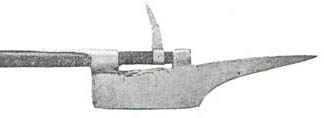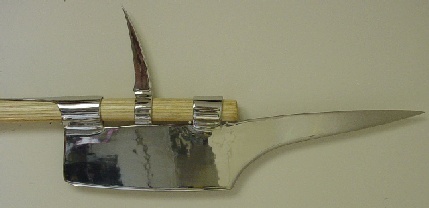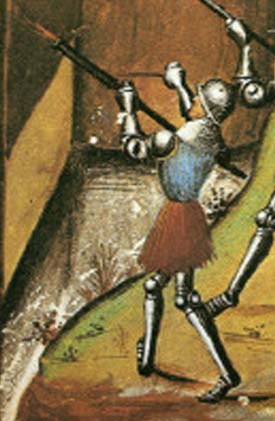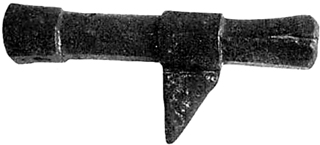

I have always been interested in medieval weapons. If you ever get a chance to, go to Medieval Times in Kissimmee St. Cloud Florida... GO! They have an awesome museum of torture devices that made the girl I was dating at the time almost vomit. (It was before I met my wife so I don't have to worry about my first attempts at medieval weapons being used against me!!) The Handgonne below, is loosely based on "Handgonners assaulting a castle", from a manuscript of 1468 (Burney MS 169, British Museum), the 1411 Codex Vindobana (Austrian National Library, Vienna) and reference to "(793) HandGonne" available from This next Handgonne is based on that used by the "lower" of the two soldiers depicted assaulting a castle in the 1468 "Qinte Curce painting" (British museum, London). My reproduction has fired up to 150-grain loads of (modern) black powder, several score of 1/2" diameter lead bullets and countless "wads". This original form of "blank" propels only the plug of grass, or other handy flora, used in place of the modern fabric patch. The purpose of this media is to create an "air-tight" seal, harness the propellants force and project the bullet when ignited. Generally speaking, bullets were not of the highest quality at the time of the first firearms. The users of such ammunition found that if the ball was too tight and forced into the barrel, they were likely jam during discharge and injure or kill the shooter with shrapnel from their own exploding guns. They therefore preferred their bullets slightly smaller then the weapon's true caliber. Using a smaller bullet without the afore mentioned wadding would allow a substantial portion of the expanding gasses to flow around and past the bullet which, while guards against exploding the barrel, does severely diminishing the projectile's effectiveness. Vegetations such as grass, mosses and peat made ideal wadding as users weren't as likely to get them packed so tight that they lodge in the barrel, yet could easily acquire and retain a good seal. And this weapon is based on a Swiss hand cannon from the late 1300's (Historisches Museum, Bern). It is not yet finished, though it is close. Two iron bands need to be wrapped around the front stock and barrel to positively affix it to the body and complete the aesthetic match to the original. This cannon's capacity is up to 300 grains of (modern) black powder.
The last of my reproductions is based on multiple 14th Century Hakenbüchse. This firearm also fires 1/2” diameter bullets, however it is only rated at 75 grains. As with the Swiss Hand Cannon above, a hook projects from the underside of the weapon. There are two (main) lines of thought on the purpose of this feature. One is that is was meant to hook over a stationary mass to counter the recoil of the weapon. The other is it was intended for use as a war hammer/pick. Firearms of the middle ages, like most other things, were called by many different names. Some such variants include: Gonne Handgonne Handgyns Hakenbüchse (Hook Can) refering to the under hook and the can or barrel Hakenbuchse (without the umlaut*, translates as Hook Socket) refering to the under hook and the socket mounted barrel Faustbüchse (Fist Can) refering to usually un-mounted barrel weapons. (See Below) Some Faustbüchse are equipped with hooks that are primarily meant to brace the weapon for discharge as there is no "stock" to maintain a firm hold of the weapon by. Luntenbüchsen (Slow Match Can) refering to firearms constructed without the under hook or an affixed igniter. Several hand held igniters were used with this type of weapon. Slow match was by far the most popular, whether held in one's hand or affixed to a rod of sorts. Red-hot iron "wands" were also use, though much less common. My plans for a medieval crossbow have not developed as of yet for several reasons; the most prominent of which being time. * Umlauts are the diacritic mark (two dots) placed over a vowel, especially in German, to indicate a change in a vowel sound caused by partial assimilation especially to a vowel or semivowel occurring in the following syllable. Copyright Terms,
Copyright Wolfram von Taus © 2007
This voulge is a recreation of a south German / Swiss artifact outlined in A Glossary of the Construction, Decoration and Use of Arms and Armor in All Countries and in All Times Together with Some Closely Related Subjects by George Cameron Stone.

Image of Original

Recreation Voulge
Up to 200 grains of (modern) black powder may be used to fire the 3/4" diameter cast lead balls for this gonne. The length of the pole the gonne is mounted to, dictates the discharge stance. Shorter gonne with poles (up to about 3' long) fire while setting on the shoulder. Those with medium length poles (3 to 5') are meant for firing from under the arm. This particular design uses a longer (6' pole) and is intended to be braced by the arch of the users foot and the ground. It is held at a shallow angle while crouched in a fencer's "lunging position". The serpentine match arm was the ideal igniter for this stance as it was auto-centering to the primer "pan", and it kept the user further away from the barrel incase of explosion.
Surprisingly enough, the recoil of such a large powder load was negligible when this replica was discharged from both the under-arm and atop the shoulder stances.

Image of Original

Recreation .75 cal. Serpentine Match Handgonne

Barrel of Recreation Serpentine Match Handgonne

Detail from the "Qinte Curce painting"

Recreation .50 cal. Qinte Curce Luntenbüchsen

Barrel of Recreation Qinte Curce Luntenbüchsen

Image of Original

Recreation 1.50 cal. Swiss Hand Cannon
As stated above, even with a 200 grain charge (a heavy load 12ga. shotgun shell has near 100 grains of sufficiently more powerful gun powder to offer comparison) the recoil is not sufficient to require the weapon be hooked over a wall, tree limb or such to be controlled while firing. Anyone who has ever fired black powder guns knows reloading safely takes time. Medieval shooters only had time for a few shots before their opponent was upon them, at which point their firearm became a glorified club. Many treatises have described just such a use. Hakenbüchse are very similar to war hammer/picks in shape and size. While I can see the hook’s use as a stabilizer on very large gonne like hand cannons, these observations combined lead me to believe it was more often used as a secondary weapon.

Recreation .50 cal. Hakenbüchse
![]()
![]()
![]()
![]()
![]()
![]()
![]()
NOTE: Although I have not been able translate the word lunten to English, I have correlated it to Germanic writings regarding the fabrication of slow burning ignition devices identical to Matchcord.

Image of Original Faustbüchse